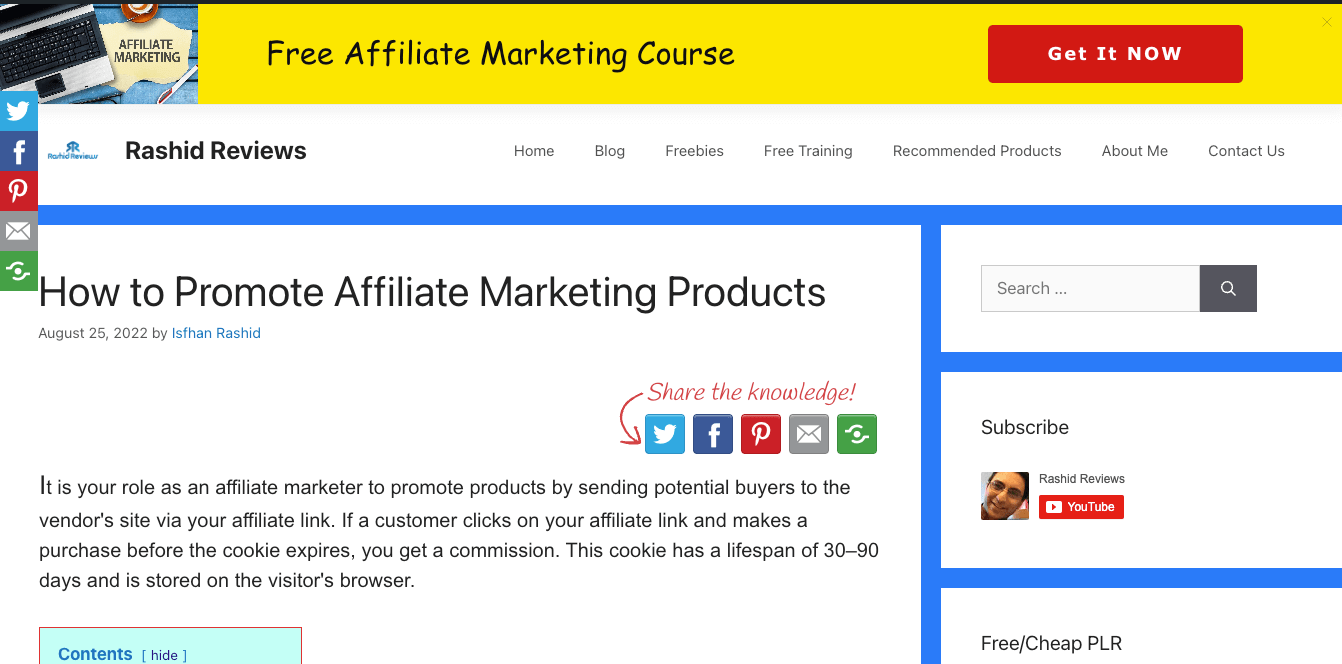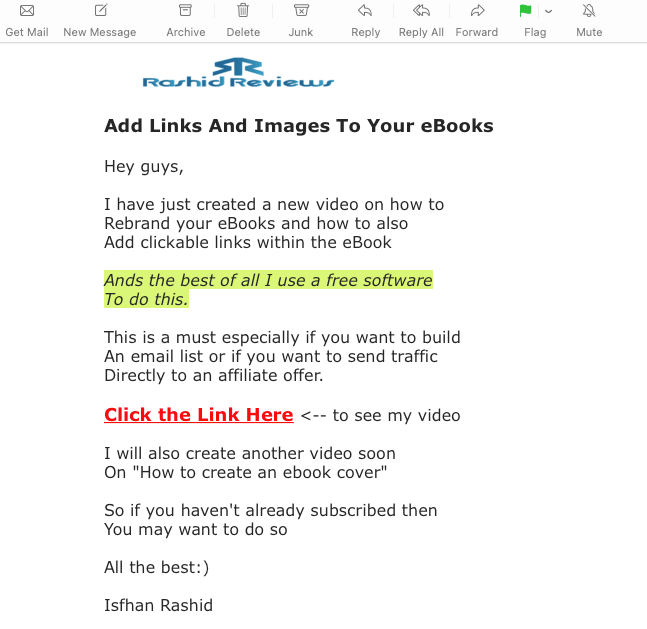It is your role as an affiliate marketer to promote products by sending potential buyers to the vendor's site via your affiliate link.
If a customer clicks on your affiliate link and makes a purchase before the cookie expires, you get a commission.
This cookie has a lifespan of 30–90 days and is stored on the visitor's browser.
Given the significance of the affiliate link in producing affiliate sales, it is prudent to maximise the efficiency of your use of affiliate links.
Everything you need to know about affiliate links, including how they work, where they should go, and how to track and promote them, is included in this piece.
The more effective your utilisation of affiliate links is, the more money you'll make.
But let's cover the fundamentals before diving into the specifics.
What are affiliate links?
Affiliate links, also known as tracking URLs, are those that include a unique identifier (ID) or user name of the affiliate.
Used to monitor the flow of customers from an affiliate's site to a retailer's, these links are an integral part of any successful affiliate marketing strategy.
Each affiliate has a special link that, when clicked, places a cookie on the visitor's browser, allowing the merchant to keep tabs on how many people came to the store from that link and how many ultimately made a purchase.
How To Apply For Your Affiliate Link(Video)
How To Apply For Your Affiliate Link-Munchey(Video)
How to promote affiliate links?
Pay attention to the following things when choosing affiliate products that are right for your audience:
- product-audience fit
- market demand
- competition
- product price
- commission type and rate
- sales cycle length
- additional incentives
Choosing the right affiliate products to sell is obviously crucial to your success.
But so is picking the right ways to advertise.
We've written before about the different kinds of affiliate partners and the sources of traffic that everyone can use.
But if you're a blogger who wants to use affiliate links to make money from your site (or audience), here's what you should do:
- Insert affiliate links in your product reviews and tutorials
- Add affiliate links to your resources page
- Place affiliate banners on your website
- Use affiliate links in your newsletters and email sequences
- Embed affiliate links into your video content
- Promote affiliate links on social media and forums
- Link to your affiliate offers directly on Medium
- Include affiliate links to your own products
Include links to your affiliate programme in any product reviews or tutorials you write.
As an affiliate marketer who focuses on content, you probably already know that you need reviews and tutorials.
Your money comes from reviews and comparisons, which we can think of as the same thing.
They go after people who are ready to buy and bring in real sales.
Tutorials and guides are more for getting traffic and being seen as an expert in your chosen niche.
But you need both to make your website a brand.
Your content shouldn't just be for making money all the time.
To make content that people want to share, you need to know a lot about the products you're promoting.
To get qualified traffic, you need to have a strong focus on the product and the user, as well as titles and subheadings that are optimised for keywords. Of course, you can't forget to build links.
Try to tell a potential customer everything they might want to know about the product. Use examples and screenshots, and don't be afraid to point out the product's possible flaws. Share what you know and how you did it. Being honest helps a lot.
Lastly, add at least one call-to-action (CTA) to the page that uses your affiliate link.
And if you can offer perks like discounts, you can use that to your advantage by, for example, asking people to sign up for your newsletter to get a special deal.
Just don't try to rank for keywords like "discount" in order to make easy money.
Most affiliate programmes won't let you do that, and you'll lose your affiliate account if you do.
Most of the time, contextual links are better at driving sales than banners, but there is room for both.
Banners have the benefit of being nice to look at.
You should see an example of a top banner on this page.

These are easy to put in your page's sidebar, header, footer, or in the text of your page.
Your affiliate link is already part of the code that you just have to copy and paste onto your page.
In general, the higher up on your page the banner is, the more people will click on it.
Visitors who want to buy, on the other hand, tend to read your content more carefully.
Because banners look more like ads than contextual links, and because many people ignore them, you should use them as little as possible.
But they also work with other ways to market, like social media and email campaigns.
If you want to send emails to people who have signed up for your blog, you must already have an audience. A good place to start is by adding an email sign-up form to your website.
Your newsletter does more than one thing. It's a way to get to know your blog readers, spread your blog posts, and advertise your affiliate products. If possible, in that order.
Getting a visitor to sign up for your newsletter means that at least some of the information in your emails should be useful.
And if they can, they should also give you perks like your own guides that aren't available online or special deals on the products you sell as an affiliate.
Here is an example of one of my emails:
If you decide to send each new subscriber a series of emails, you might not want to put any affiliate links on the first email.
Start by building trust. And if, for example, you start sending out a monthly newsletter, one affiliate link per newsletter is probably enough advertising.
There are a lot of guides on how to use affiliate links on Facebook, Twitter, Pinterest, and TikTok, as well as on forums like Quora and Reddit.
You can find these with a simple Google search and use the articles that you find most helpful.
To promote affiliate links through these channels, you need a group of people who are likely to buy.
The good thing about social media is that you can put direct affiliate links in many of your posts.
This is true, for example, of Twitter, Facebook, and Pinterest.
You can promote your own products through affiliate links
To supplement their income, many affiliates provide digital goods like ebooks and courses.
Another way to advertise is to include your affiliate link in the body of your product, if that makes sense.
Just be careful not to come off as making a hard sell.
Should You disclose affiliate links?
Because it's against the law to endorse and promote products for money, you have to tell people about your affiliate partnerships.
Affiliate disclosure is a way to tell people who visit your website that some of the products you talk about and link to may be affiliate products for which you may get paid.
It lets people know what your incentives are and helps them make decisions.
In addition to the disclosure rules set by the FTC (in the US) and the GDPR (in the EU), affiliate programmes have their own terms and conditions that include a disclosure rule.
By not telling them about your links, you would also be breaking their rules.
So, if you publish content on your website that has affiliate links, make sure to put your disclosure in a place that is easy to find.
Here's an example of one of my affiliate disclosures.
"A quick note about the reviews on this site: I am an affiliate for every product I review. However all my reviews are done as honestly as possible and I make no promises to the vendor prior to writing my review. Should you click a link on this site that takes you to a paid product this link will be an affiliate link and I will be paid a percentage of the sales price should you decide to purchase that product."
Conclusion
Now you know where to get your affiliate link and how to use it to get started with affiliate marketing.
After that, using the options that were presented before, you may make a decision on where to place your affiliate links and continue monitoring the outcomes.
You won't be able to start reaping the rewards until you've determined the optimal method for putting your offer in front of the appropriate audience.
Isfhan Rashid




